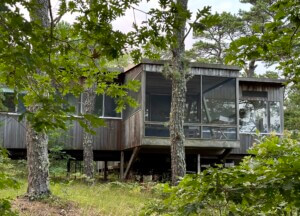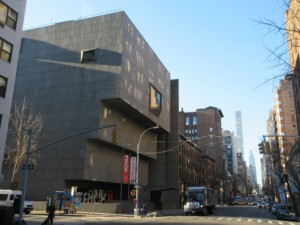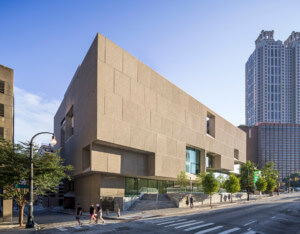When one thinks of Marcel Breuer’s work in New York, the Whitney immediately comes to mind. But there’s a substantial collection of Breuer buildings in the Bronx, including the Lehman College Art Gallery, where Breuer morphed from Bauhaus to Brutailism in one structure. On Monday night, two separate group shows opened at the gallery, one curated by gallery director Susan Hoetzel, the other was part of El Museo del Barrio’s biennial, “The (S) Files.” From an architectural standpoint, one artist from each show stood out because of their direct response to Breuer’s hyperbolic paraboloid columns which punctuate the space.
The art gallery was initially built as a library in 1958. All the stacks were to be kept in the basement. Breuer described the six giant paraboloid columns which define the space as large inverted umbrellas. The forms functioned as both roof and ceiling to a grand reading room. A curtain wall wrapped around the north and west sides of the building while a honeycomb-like sunscreen ran around the south and east.
The librarian and Breuer clashed throughout the design process on the library’s layout and once Breuer was off the premises she cluttered the space with bookshelves and the architect disowned the project. By the 1980s the building was converted into a gallery and classrooms. Fire walls divided the space. But two of the gallery spaces feature the columns as works of art. It was these two columns that informed the work of artists Gisela Insuaste and Barbara Andrus.
In the case of Andrus, the encounter wasn’t exactly an embrace as much as a reaction. Her site specific installation regards the paraboloid column with wary respect. Composed of branches from a variety of trees, including apple, holly, cherry, mountain ash, basked willow, and tiger maple, the structure snakes around the space creating spiral hallways whose walls wisp up and slightly away from Breuer’s central column. “The columns were sort of daunting in a way,” said Andrus. “It was such a strong element that I couldn’t completely ignore it.” The sheer height of the piece, some twenty feet at one point, nearly saps the columns robust power. The interior of the piece takes the visitor far away. Walking through the sculpture feels like being enveloped a by beach-side cove, living up to its name, Forest Extract: Walking Between Swans Island and Sears Island.
If Andrus’ piece takes you away to Maine, then Insuaste’s brings you to an Ecuadorian rooftop in Brooklyn. Though Insuaste did enough research to pay homage to the master, there’s no doubt, she takes him on in full frontal aesthetic assault. For three weeks the artist saturated the paraboloid in rich colors of an Ecuadorian textile, with purple bunting up against grey and blue in one section, or melon, chartreuse, and mint in another. Each panel is separated by silver leaf, which was inspired by silver paint on Brooklyn rooftops where she lives. “I like the idea of it being an inverted umbrella, so I like the idea of bringing the outside in,” she said. When asked if she’d like to do the same to other masterworks she mentioned Corbusier and Niemeyer. “I’m up for it,” she said.










